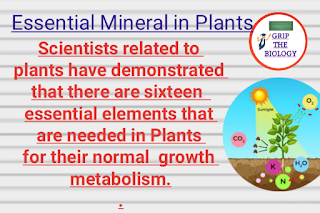Essential elements in Plants
- Scientists related to plants have demonstrated that there are sixteen essential elements that are needed in plants for their normal growth and metabolism.
- These elements are categorized into the following categories-
- Nutrients that are required by the plants at larger amounts are called Macronutrients or termed as Primary nutrients.
- These primary nutrients are carbon, hydrogen, nitrogen, oxygen, phosphorus, and potassium.
- Nutrients that are required by the plants at medium amounts either excess or least are called secondary nutrients. The secondary nutrients are calcium, magnesium, and sulphur.
- And the third one is Micronutrient. Word trace nutrients are also used for micronutrients .
- Micronutrients are boron, chlorine, copper, iron, manganese, molybdenum, and zinc.
- Gold selenium.cobalt, nickel, silicon, sodium, and vanadium are other nutrients also absorbed by the plants.
Defeciency symptoms of essential elements
- The concentration of the essential element must be normal in plant if concentration remain present below the normal range than plant growth is retarded.This concentration is called as critical concentration.
- The element is said to be deficient when present below the critical concentration.
- In the absence of any essential element, plants develop various morphological changes.
- These changes are indicators of deficiencies of essential elements and are called deficiency symptoms.
- The deficiency symptoms may different from element to element and they disappear when the deficient elements get fulfilled by the plant.
- The deficiency symptoms appear first in the young tissues whenever the elements are relatively immobile and are not transported out of the mature organs.
- For example, elements like sulphur and calcium are a part of the structural component of the cell and hence are not easily released.
- The common deficiency symptoms in plants include chlorosis, necrosis, stunted plant growth, premature fall of leaves and buds, and inhibition of cell division.
- Chlorosis is the loss of chlorophyll leading to yellowing in leaves, caused by the deficiency of elements Nitrogen, Potassium Magnesium Iron zinc Molybdenum.
- Necrosis is the death of tissue, particularly leaf tissue, due to the deficiency of Calcium Magnesium copper.
- Low level of Nitrogen sulphur Molybdenum affect the process of cell division and also delay in flowering.
- Deficiency of Essential nutrient affects specific functions of plant growth and development .Plant growth is limited.
- Essential nutrients must be broken down into its basic form for the intake of plants.
- The nutrient must be in the form of either a positively charged ion or a negatively charged ion.
- If elements are converted into its basic forms then plants cannot use them.Plants cannot use elements in their original form and if it is present in high concentrations in the soil.
- Plants take in almost all of the essential nutrients through their roots. The exception is carbon, which is taken in through leaf pores, or stomata.
- Microorganisms like Bacteria Fungi cyanobacteria or Biofertilizers break down organic compounds into inorganic compounds.
- This process is called mineralization.It is one of the important steps of decomposition.
- For example Fungi makes available for some plants to take up phosphorus by increasing the size of the roots.
- Due to the lack of an essential nutrient, Plant cannot complete its life cycle.
- The seed may not germinate. The development of roots, stems, leaves, flowers ,fruit may be affected. Plant is not able to produce seeds.
Toxicity of Elements
- If there is too much nutrient present in plants, it can harm and even kill plants.
- For example, having too much nitrogen can cause a plant to grow more leaves but less or no fruit. Too much manganese can make the leaves turn yellow and eventually die. And excess boron can kill a plant.
- The increase of elements in more amounts causes toxicity.
- Any mineral ion concentration in tissues that reduces the dry weight of tissues by about ten per cent is considered toxic.
- Excess of an element may inhibit the uptake of another element.
- For example- the prominent symptom of manganese toxicity is the appearance of brown spots surrounded by chlorotic veins.
- Manganese competes with iron and magnesium for uptake and with magnesium for binding with enzymes.
- Manganese also inhibits calcium translocation in shoot apex; therefore, excess of manganese may induce deficiencies of iron, magnesium and calcium.

Comments
Post a Comment